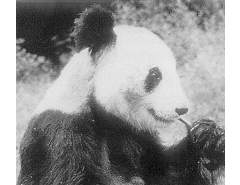
 A Panda eating Bamboo |
Ailuropoda melanoleuca
Bai Bao (White Leapord) Fiery Fox Shi Ti Shou (Iron Eating Beast) Shining Cat Cat Bear Black and White Bear |
The Giant Panda is one of the most misunderstood animals on the planet. For many years, it was believed to be a type of racoon, like the similarly named red panda. However, genetics testing and observation have revealed that the panda is in fact, a bear. It has several adaptations that make it unusual. First is the fact that it has six digits on the front paws, giving it an opposable thumb ideal for holding onto the stalks of bamboo which it consumes in great amounts. The genitalia of the male are rear-pointing and small which is also decidedly unbearish, and much more like those of the red panda. It has only been since 1995 that the Panda has been officially considered a bear.
Typical pandas have a large head, and distinct white and black coloration which contrasts sharply with the deep green of their natural habitat. Pandas can only be found in six tiny regions in southwest China. These places are along the Tibetan plateau in Sichuan, Gansu, and Shaanzi provinces. Combined, these areas are less than 5,400 square miles of very high altitude (4,000-11,500 ft.) mountain forests grown thick with patches of more than 30 species of bamboo. The bears themselves have home ranges from 1.8 to 3.3 square miles. The territories of the males often overlap those of a number of females.
Newborn pandas weigh between 3 and 5 ounces. Males grow to 190-275 pounds and 64-76 inches in length, with females being slightly smaller and lighter at 155-220 pounds. They reach sexual maturity between ages 4 1/2 to 6 1/2 years and mate once during the spring months of March, April, and May. The females are in estrus for anywhere from 1 to 3 weeks, but are only really receptive for a few days of that time. During August and September, pregnant females give birth to anywhere from one to three cubs, with one being the more common. The cubs are weaned at nine months, but often stay with their mothers for more than two years.
Like most bears, pandas are solitary animals. Females with cubs being the only exception. They mark their territories by scratching trees and by rubbing a musky anogenital gland against rocks and trees. Additionally, they communicate with different vocalizations. Scientists have identified 11 distince calls, but cannot identify the exact function of all of them.
Pandas are quite vegitarian, making bamboo 99% of their diet. Adults can eat anywhere between 26 and 33 pounds of it in a day, and with soft new shoots up to 84 pounds! Incredibly, that's almost 40% of their body weight! Ocassionally they consume meat and some other plants.